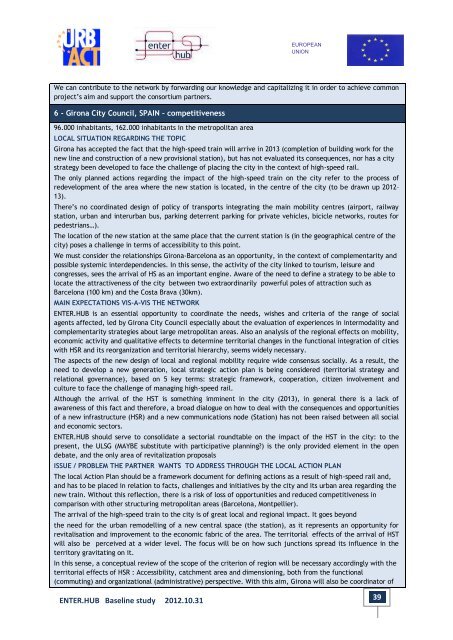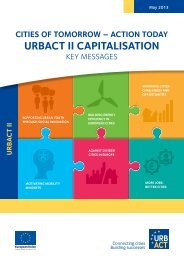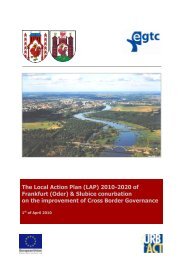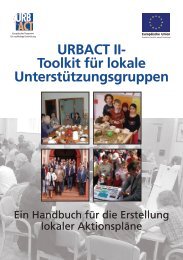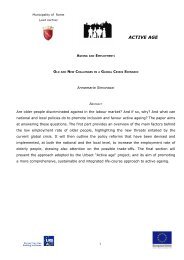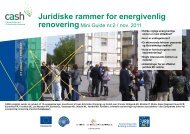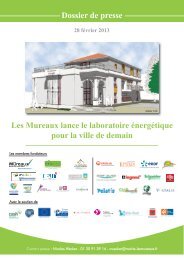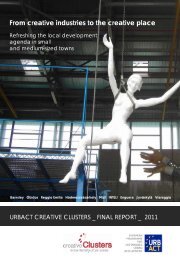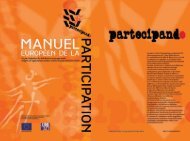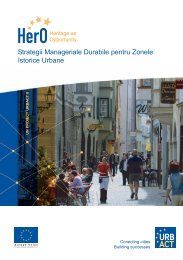ENTER.HUB_Baseline study PDF, 6 Mo - Urbact
ENTER.HUB_Baseline study PDF, 6 Mo - Urbact
ENTER.HUB_Baseline study PDF, 6 Mo - Urbact
You also want an ePaper? Increase the reach of your titles
YUMPU automatically turns print PDFs into web optimized ePapers that Google loves.
EUROPEAN<br />
UNION<br />
European Regional<br />
Development Fund<br />
We can contribute to the network by forwarding our knowledge and capitalizing it in order to achieve common<br />
project’s aim and support the consortium partners.<br />
6 - Girona City Council, SPAIN – competitiveness<br />
96.000 inhabitants, 162.000 inhabitants in the metropolitan area<br />
LOCAL SITUATION REGARDING THE TOPIC<br />
Girona has accepted the fact that the high-speed train will arrive in 2013 (completion of building work for the<br />
new line and construction of a new provisional station), but has not evaluated its consequences, nor has a city<br />
strategy been developed to face the challenge of placing the city in the context of high-speed rail.<br />
The only planned actions regarding the impact of the high-speed train on the city refer to the process of<br />
redevelopment of the area where the new station is located, in the centre of the city (to be drawn up 2012–<br />
13).<br />
There’s no coordinated design of policy of transports integrating the main mobility centres (airport, railway<br />
station, urban and interurban bus, parking deterrent parking for private vehicles, bicicle networks, routes for<br />
pedestrians…).<br />
The location of the new station at the same place that the current station is (in the geographical centre of the<br />
city) poses a challenge in terms of accessibility to this point.<br />
We must consider the relationships Girona-Barcelona as an opportunity, in the context of complementarity and<br />
possible systemic interdependencies. In this sense, the activity of the city linked to tourism, leisure and<br />
congresses, sees the arrival of HS as an important engine. Aware of the need to define a strategy to be able to<br />
locate the attractiveness of the city between two extraordinarily powerful poles of attraction such as<br />
Barcelona (100 km) and the Costa Brava (30km).<br />
MAIN EXPECTATIONS VIS-A-VIS THE NETWORK<br />
<strong>ENTER</strong>.<strong>HUB</strong> is an essential opportunity to coordinate the needs, wishes and criteria of the range of social<br />
agents affected, led by Girona City Council especially about the evaluation of experiences in intermodality and<br />
complementarity strategies about large metropolitan areas. Also an analysis of the regional effects on mobility,<br />
economic activity and qualitative effects to determine territorial changes in the functional integration of cities<br />
with HSR and its reorganization and territorial hierarchy, seems widely necessary.<br />
The aspects of the new design of local and regional mobility require wide consensus socially. As a result, the<br />
need to develop a new generation, local strategic action plan is being considered (territorial strategy and<br />
relational governance), based on 5 key terms: strategic framework, cooperation, citizen involvement and<br />
culture to face the challenge of managing high-speed rail.<br />
Although the arrival of the HST is something imminent in the city (2013), in general there is a lack of<br />
awareness of this fact and therefore, a broad dialogue on how to deal with the consequences and opportunities<br />
of a new infrastructure (HSR) and a new communications node (Station) has not been raised between all social<br />
and economic sectors.<br />
<strong>ENTER</strong>.<strong>HUB</strong> should serve to consolidate a sectorial roundtable on the impact of the HST in the city: to the<br />
present, the ULSG (MAYBE substitute with participative planning?) is the only provided element in the open<br />
debate, and the only area of revitalization proposals<br />
ISSUE / PROBLEM THE PARTNER WANTS TO ADDRESS THROUGH THE LOCAL ACTION PLAN<br />
The local Action Plan should be a framework document for defining actions as a result of high-speed rail and,<br />
and has to be placed in relation to facts, challenges and initiatives by the city and its urban area regarding the<br />
new train. Without this reflection, there is a risk of loss of opportunities and reduced competitiveness in<br />
comparison with other structuring metropolitan areas (Barcelona, <strong>Mo</strong>ntpellier).<br />
The arrival of the high-speed train to the city is of great local and regional impact. It goes beyond<br />
the need for the urban remodelling of a new central space (the station), as it represents an opportunity for<br />
revitalisation and improvement to the economic fabric of the area. The territorial effects of the arrival of HST<br />
will also be perceived at a wider level. The focus will be on how such junctions spread its influence in the<br />
territory gravitating on it.<br />
In this sense, a conceptual review of the scope of the criterion of region will be necessary accordingly with the<br />
territorial effects of HSR : Accessibility, catchment area and dimensioning, both from the functional<br />
(commuting) and organizational (administrative) perspective. With this aim, Girona will also be coordinator of<br />
<strong>ENTER</strong>.<strong>HUB</strong> <strong>Baseline</strong> <strong>study</strong> 2012.10.31<br />
39


